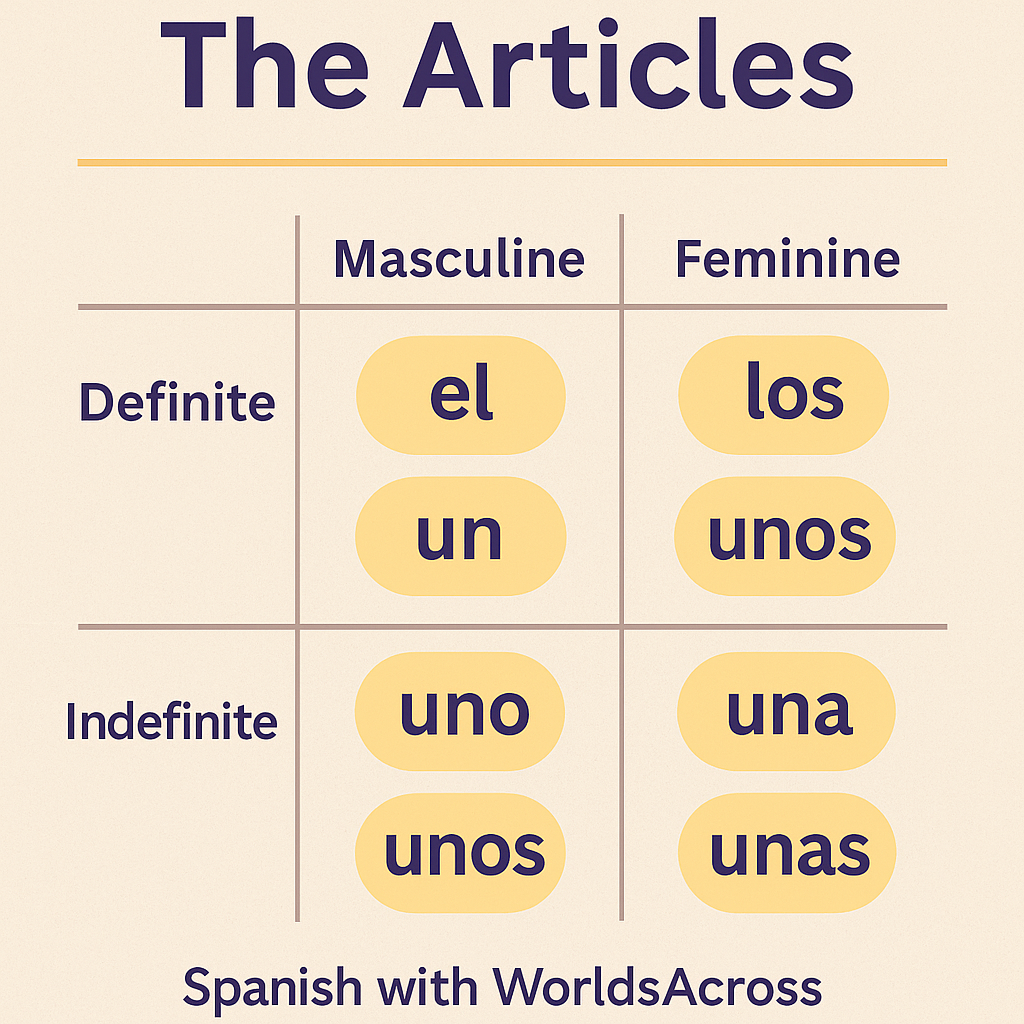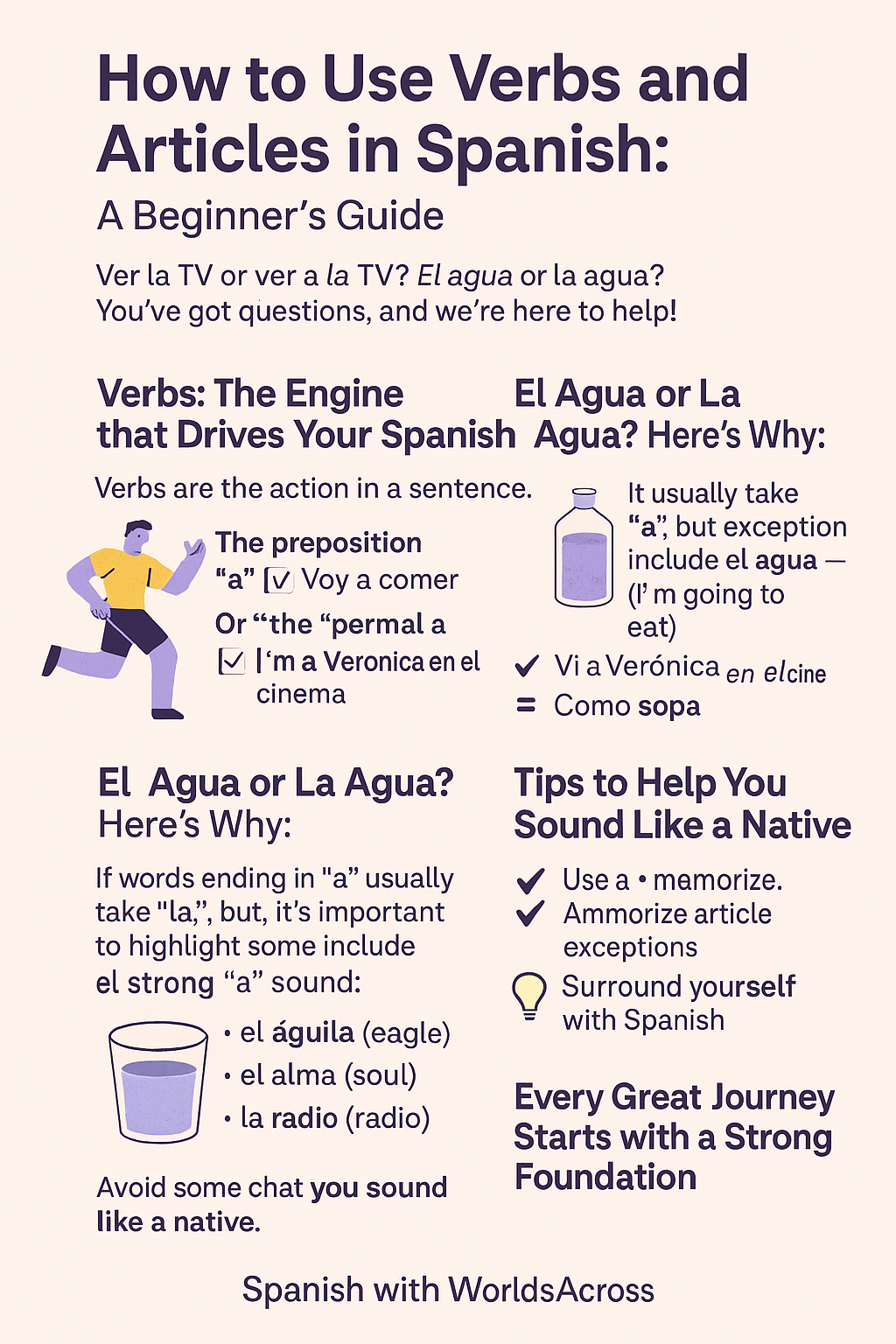How To Correctly Use Verbs and Articles In Spanish: A Student's Guide
Ver la TV or ver a la TV? Comer pizza or comer a pizza? These are some of the most common doubts among Spanish learners. And let’s not even start with articles! You’ve probably asked yourself whether it’s la mano or el mano, or maybe el agua or la agua. But don’t worry—you’re not alone! Everyone learning a language has been there.
Learning how to use verbs and articles in Spanish from the very beginning will help you build confidence, sound more natural, and take firm steps toward the fluency you’re aiming for.
That’s why we created this guide just for you, dear beginner student. In the following lines, I’ll show you how to use Spanish verbs and articles clearly and simply so you can start speaking with confidence, feel secure, and enjoy every step of this beautiful journey called learning Spanish.
Let’s go!
Verbs: The engine that drives your Spanish
Just like our teachers used to say in school: verbs are the action in a sentence. However, even though this idea is easy enough to understand, there’s one question that always brings confusion: when should I use “a” before a verb? Let me explain:
The mystery of the preposition “a” before a verb
The first thing to understand is that not all verbs require the preposition “a”. However, there are certain verbs that do need it when followed by another verb in the infinitive form (remember: infinitives are the base form of the verb—comer, hablar, vivir, etc.).
For example:
-
Voy a comer
-
Te voy a enseñar a cantar
-
Comencé a entrenar a las 9
-
Estoy empezando a hablar español
Do you see how these verbs need the preposition “a” to connect with the next verb? But be careful—not all verbs need it:
-
Quiero comprar una pizza
-
¿Puedo ir a verte?
-
Necesito dormir un poco más
In these cases, we don’t use “a” because verbs like querer, poder, and necesitar connect directly with the infinitive. Interesting, right?
The “personal a”: A small detail that says a lot
Great job! Now you have a better idea of when to use “a” before a verb. But there’s another important element to explore: the “personal a.” In Spanish, we also use “a” when referring to people or beloved pets.
For example:
- ✅ Vi a Verónica en el cine
- ✅ Extraño a Manchas, mi dálmata
- ❌ Como a sopa → ✅ Como sopa
- ❌ Escucho a música → ✅ Escucho música
Now you know: if you truly want to use verbs and articles in Spanish like a native, don’t overlook this small—but essential—detail! These kinds of structures often confuse beginners, but they’re a core part of basic Spanish grammar.

El agua or la agua? Here’s why:
If we’re talking about beginner Spanish grammar, we can’t skip articles. The rule is simple: words ending in “a” are generally feminine and take “la”, and those ending in “o” are masculine and take “el.” But why, then, do we say “el agua” and “la mano”? Let me explain:
Agua is a feminine word, but because it begins with a strong “a” sound, we use “el” instead of “la” to avoid awkward pronunciation. Other similar cases include: el águila, el área, el alma.
As for la mano, that’s an exception. It comes from the Latin word manus, which is feminine. Even though it ends in “o,” it retained its feminine gender. That’s why we say la mano. Other exceptions include: la radio, la foto, la moto. Fascinating, right?

Tips to help you sound like a native
Well done! You’ve got the basics. Now, to help you use Spanish verbs and articles like a pro, here are some clear and helpful tips:
-
When you have two verbs in a row, check if the first one needs a preposition. If it’s “a,” use it: Voy a comprar comida.
-
Use “a” when referring to people or pets: Estoy buscando a Oscar.
-
Don’t use “a” when referring to inanimate objects, things, or food: Escucho música, veo la TV.
-
Memorize some article exceptions: la mano, el agua, el alma, la radio.
-
Surround yourself with Spanish as much as possible: podcasts, music, movies, TV shows, language learning platforms.
Every great journey starts with a strong foundation
Congratulations! Now you have a clear idea of how to use verbs and articles in Spanish. Beginner Spanish grammar might seem like a maze at first, but with time and dedication, you’ll build a solid foundation to carry you through your language journey.
Remember: every small step you take, every question you answer, and every word you practice brings you closer to mastering the language. So don’t give up, dear student. Fluency isn’t a distant dream… it’s a path you’re already walking!




